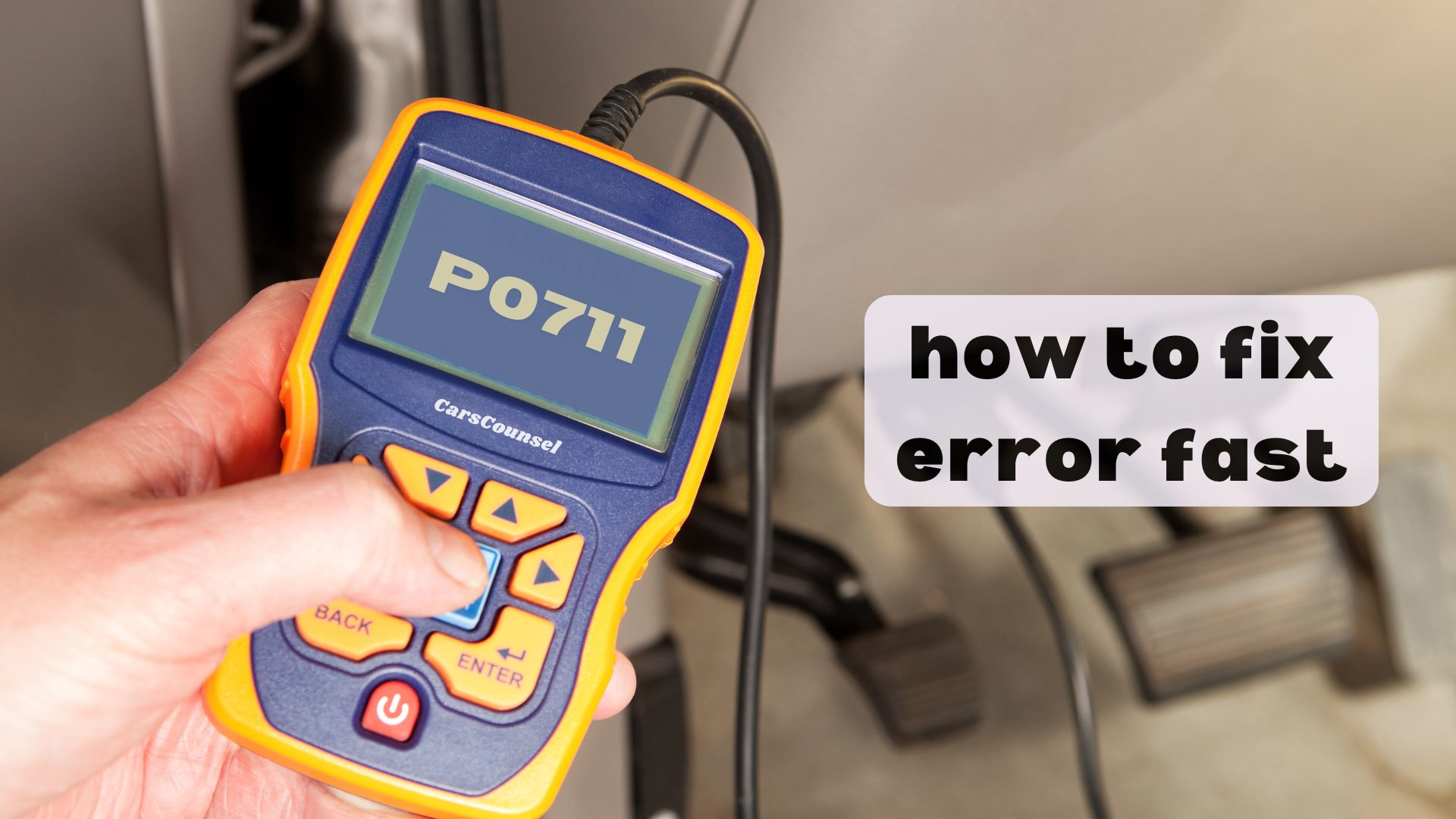Imagine you’re driving to an important meeting when suddenly, the check engine light comes on. A quick diagnostic shows a P0711 code. This means there’s a problem with the transmission fluid temperature sensor, which could lead to serious transmission issues if you don’t fix it.
But don’t worry, you can follow some simple steps to solve this problem quickly. Check the fluid levels, inspect the wiring, and test the sensor. Each of these steps can save you time and money.
Let’s break down these steps so you can get back on the road fast.

Quick Navigation
Key Takeaways
- Check and replace the bad transmission fluid temperature sensor to fix the P0711 code.
- Use a scan tool to find and record all related error codes.
- Make sure the transmission fluid levels are correct and clean.
- Look for and fix any damaged wires or connectors in the transmission system.
What Is the P0711 Code?
The P0711 code, which is a part of the more extensive set of OBD2 codes, is a common issue that points to a problem with the transmission fluid temperature sensor. When your car’s main computer, known as the Powertrain Control Module (PCM), notices a problem with this sensor, it triggers the P0711 error code. This sensor keeps track of the temperature of your transmission fluid, which is important for making sure your transmission works well and doesn’t get damaged.
If you see this code, it’s important to figure out what’s wrong as soon as possible. Ignoring it can lead to bigger problems, like serious transmission damage that could require expensive repairs or even a full rebuild.
Symptoms of the P0711 Code
Symptoms of the P0711 Code
Recognizing the signs of the P0711 code can help you catch transmission problems early. These symptoms often point to a sensor issue affecting how well your transmission works. You might notice rough or slow shifting, unpredictable gear changes, or the transmission slipping. The check engine light usually comes on, alerting you to a problem. You could also see a drop in fuel efficiency and experience transmission overheating. Spotting these signs early can lead to quicker fixes.
| Symptom | Description | Impact |
|---|---|---|
| Harsh or delayed shifting | Transmission shifts roughly or slowly | Poor transmission performance |
| Erratic gear changes | Unpredictable shifting between gears | Unstable driving experience |
| Transmission slipping | Loss of power during acceleration | Possible transmission damage |
| Check engine light | Warning light on dashboard | Signals a sensor issue |
| Reduced fuel efficiency | Lower miles per gallon | Higher fuel consumption |
Common Causes
Among the common causes of the P0711 code, a bad transmission fluid temperature sensor is often the main problem. The sensor can wear out or get damaged over time due to tough conditions.
Wiring issues, like broken or wet wires, can mess up the sensor’s signals. Sometimes, the car’s computer (PCM) can act up and send wrong information, making it hard to figure out what’s wrong.
Not taking care of your car, like skipping transmission fluid checks, can make these problems worse. Very hot or very cold weather can also affect the sensor.
To fix this, use diagnostic tools to check if the transmission fluid is low or dirty, which can cause the code. Make sure the sensor and wiring are in good shape to avoid future issues.
Fix these problems quickly to prevent serious transmission damage.
Affected Vehicle Models
You often see the P0711 code in specific cars like the 2003-2007 Honda Accord, Chrysler 300C, and Ford Expedition. These cars tend to have issues with the transmission fluid temperature sensor, which can mess up the sensor’s reliability.
If this code pops up, it can lead to serious problems, like poor transmission performance and expensive repairs if you don’t fix it quickly. A bad sensor in these models can cause bad shift timing and overheating, which puts extra stress on the transmission.
Keeping the transmission sensor accurate is crucial for good vehicle performance and to avoid more damage. Regular maintenance and quick action on this code can reduce risks and make your vehicle’s transmission more reliable.
Checking Fluid Levels
One of the first things you should do when dealing with the P0711 code is to check your transmission fluid levels.
Start by finding the transmission dipstick in your vehicle. With the engine running and warmed up, put the car in park. Pull out the dipstick and wipe it clean. Then, put it back in all the way and pull it out again to check the fluid level.
The fluid should be within the marked range and should look clear and reddish. If the fluid level is low or the fluid looks dirty, add more or replace it.
Keeping your transmission fluid at the right level is important and can prevent a lot of problems. Taking care of this quickly can help you avoid bigger repairs and may even clear the P0711 code.
Using a Scan Tool
After checking the transmission fluid levels, use a scan tool to get the P0711 code and any related codes stored in the vehicle’s computer.
Connect the scan tool to the OBD-II port, usually found under the dashboard. Follow the tool’s instructions to scan for diagnostic trouble codes.
Be sure to note any extra codes that might give more clues. Using the scan tool correctly is crucial for identifying the exact problem with the transmission fluid temperature sensor circuit.
Inspecting Wiring Harness
Start by looking over the wiring harness for any signs of damage, like broken wires or rusty connectors.
Pay extra attention to spots where the wires might be damaged by heat or physical wear.
Check each connector closely for rust, as this can mess up the electrical signal and cause the P0711 code.
Make sure no wires are frayed or exposed, as this can lead to shorts or intermittent connections.
If you find any damaged wires or rust, fix or replace them right away to get things working properly again.
Keeping the wiring harness in good shape is crucial for accurate sensor readings and to avoid transmission problems.
This step is key for correctly diagnosing and fixing the P0711 code.
Testing the Sensor
Testing the Sensor
To properly test the transmission fluid temperature sensor, you’ll need a digital multimeter to check its resistance and voltage. First, disconnect the sensor from the circuit. Set your multimeter to measure resistance and connect the probes to the sensor terminals. Compare the readings with the manufacturer’s specifications to ensure the sensor is calibrated correctly. Next, switch the multimeter to measure voltage and reconnect the sensor. Turn on the ignition and measure the voltage output. Look at the data to confirm the sensor is working properly.
| Step | Multimeter Setting | Action |
|---|---|---|
| 1 | Resistance | Disconnect and measure resistance |
| 2 | Compare | Check against manufacturer’s specifications |
| 3 | Voltage | Reconnect and measure voltage |
| 4 | Analyze | Verify sensor output |
| 5 | Calibration | Confirm proper sensor calibration |
Using the multimeter correctly ensures accurate diagnostics.
Repairing and Replacing Parts
When fixing a P0711 code, you’ll need to focus on the transmission fluid temperature sensor and its wiring. Here’s what to do:
- Replace the Sensor: Change out the bad transmission fluid temperature sensor.
- Fix the Wiring: Check and repair any damaged or corroded wires.
- Calibrate the Sensor: Make sure the new sensor is set up correctly according to the vehicle’s specs.
- Reconnect and Test: Reconnect the sensor and wiring, then use a scan tool to check if everything is working.
By properly setting up the new sensor and fixing the wiring, you should be able to clear the P0711 code.
Always double-check your work by clearing the code and taking the car for a test drive to make sure the issue is gone.
Preventative Maintenance
Checking your transmission fluid regularly is key to keeping the P0711 code from coming up. Make sure your transmission fluid is clean and at the right level, as this helps the sensor last longer. Look out for any signs of dirt or low fluid levels.
Follow your car maker’s guidelines for changing the transmission fluid to keep debris from messing with the sensor. Also, take a look at the wiring harness now and then to make sure it’s not damaged.
More OBD-II Codes
Frequently Asked Questions
Can Driving With a P0711 Code Damage My Transmission?
Yes, driving with a P0711 code can harm your transmission. If you don’t replace the sensor quickly, your transmission’s performance may get worse. Fix the issue soon to avoid needing major transmission repairs or rebuilds. Try not to drive until it’s sorted out.
How Much Does It Typically Cost to Fix the P0711 Code?
If you ignore it, the repair costs can be very high. Usually, fixing the P0711 code costs between $100 and $500, including the cost to diagnose the problem. Most of the expenses come from replacing the sensor, fixing wiring, or dealing with fluid issues.
Are There Any DIY Fixes for the P0711 Code?
You can fix the P0711 code yourself. Start by checking and topping up the transmission fluid. When replacing the faulty transmission fluid temperature sensor, make sure to disconnect the battery first.
Can Extreme Weather Affect the Transmission Fluid Temperature Sensor?
Extreme weather can mess with your transmission fluid. Really hot or freezing cold conditions can affect the sensor’s accuracy, causing wrong readings and possible problems. Always think about the weather when checking for sensor issues.
How Long Can I Drive Before Fixing the P0711 Code?
You shouldn’t drive long with the P0711 code. If you ignore it, your transmission could start having serious problems. Fix it soon to avoid expensive repairs and possible transmission damage.
Conclusion
Follow these steps to fix the P0711 code quickly and effectively.
First, check the fluid levels in your vehicle.
Then, inspect the wiring harness for any damage.
Next, test the sensor to see if it’s working properly.
If you find any faulty parts, repair or replace them.
Finally, clear the error codes.
Regular maintenance is key to keeping your vehicle in top shape.
Always monitor fluid conditions and address any issues right away.
This will help prevent future problems and ensure a smooth, reliable driving experience.

